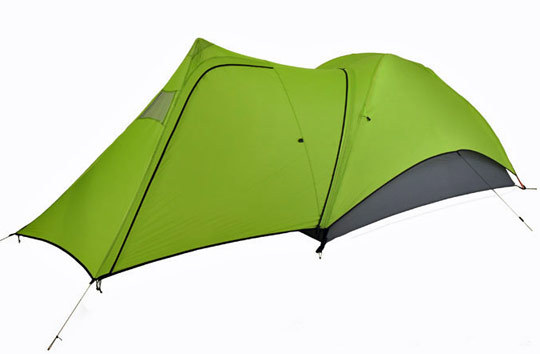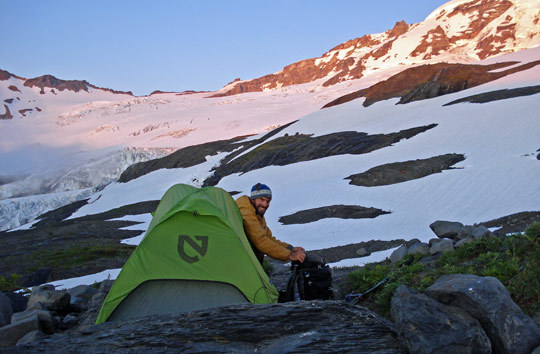MSRP: $299.95
I have never seen myself as a “bivy sack” type of guy. I enjoy crawling into the secure sanctuary of a full-blown tent when the weather turns nasty; I actually feel “sheltered from the storm,” and that kid-in-a-fort feeling makes me grin. So when I rolled into the Nemo Espri on Mt. Baker under a black sky, with gusty winds and the first spatters of rain lashing my face, it was with a deep, contented sigh that I surveyed what would be my home for the next twelve hours. After several minutes of gear organizing, my bunkmate clambered in after me. The weather continued its nosedive while we reflected on our spectacular climb with hot drinks in hand and the Espri’s cozy bubble of protection surrounding us.
That night on Mt. Baker was one of many days I spent in the Espri over a fourteen-month test period. Even though the tent is advertised as an ultralight backpacking tent, I suspected it would work for most summer alpine climbing in the Cascades and Sierra Nevada. I was right.
At three pounds, seven ounces, this isn’t the lightest two-person tent on the market, though it is exceptionally light for a double-wall. Nemo makes it happen with clever and judicious use of lightweight materials: 30-Denier polyurethane and netting. The floor and lower walls are nylon and the top half is mesh, keeping the weight of the tent body low. The same 30D nylon makes up the fly, which overlaps the lower tent body just enough to keep it waterproof. The result? A remarkably breathable tent, with very decent weather protection.
While the fabric and body design is important, but the details are important too–pole orientation and attachment, zippers, buckles, interior pockets–and they’re what make the Espri an absolute joy to use.
To begin at the beginning, setting up the tent is simple. The two poles form an X, permanently connected by a clever little swivel joint in the center. A ball-lock pins the poles to the corners of the tent so I thread them into place and no further. I snap the fabric to the poles with exterior clips attach the fly with a separate little click-in locking mechanism.
A gaping entry frames the cozy interior of the tent. The space inside is ample for two people, but it’s on the snug side, and in poor weather, the space can feel especially cramped. Generous headroom (forty inches) does help here. I can sit up and face my tentmate while eating, reading or playing cards.
A hanging gear loft is a convenient place for my pocketknife, watch, gloves and hat; it also has a headlamp pocket that diffuses the beam and softly lights the interior without blinding anyone.
One of the most unique features of the tent is the interchangeable vestibule. Stock, the Espri comes with two options: an ultralight fly door that shelters the tent but with no extra storage space, and a standard vestibule that extends out to cover a couple of packs. An extra Ben Franklin will get you the Trekking Pole Vestibule. Requiring a single trekking pole to keep it taut, this one-pound vestibule creates a huge amount of covered space. It actually adds more than fifty percent of extra room, making the whole structure seem much larger in nasty weather. It is no problem to store packs, plus boots, and still have room to crouch over a stove.

Optional Trekking Pole Vestibule, $100
While I established that the Espri’s functionality extends from backpacking into three-season alpine climbing, its versatility is stretched thin in the winter months. The large mesh walls and minimalist fly keep moisture out and provide excellent breathability; they also let wind through in gusty conditions. This is not a problem above 20 degrees. In fact, the breathability is nice. But in the teens and below, the icy flow of air brings an unwelcome chill.
In all, I am impressed with the Nemo Espri. It covers the middle ground between comfort in camp and lightweight on my back. It’s a recommendable option for a light, two-person tent with the ability to add covered space. And the solid design details make the put-up and take-down straightforward when the weather’s going to the dogs, and I need that protective bubble fast.
Pros: great attention to detail; easy and quick to set up; light for a double wall tent; ability to change vestibules; great value for price.
Cons: minimal storm protection (wind still comes through); snug for two people plus gear.
While Larry knocked the Espri for being “snug” for two people, he might be please with Nemo’s improvements in the 2012 version. They pre-bent the poles at a more aggressive angle to create extra headroom near the door. The company also responded to feedback about water dripping in through the door by sewing additional waterproof panels onto either side of the opening. –Ed.
